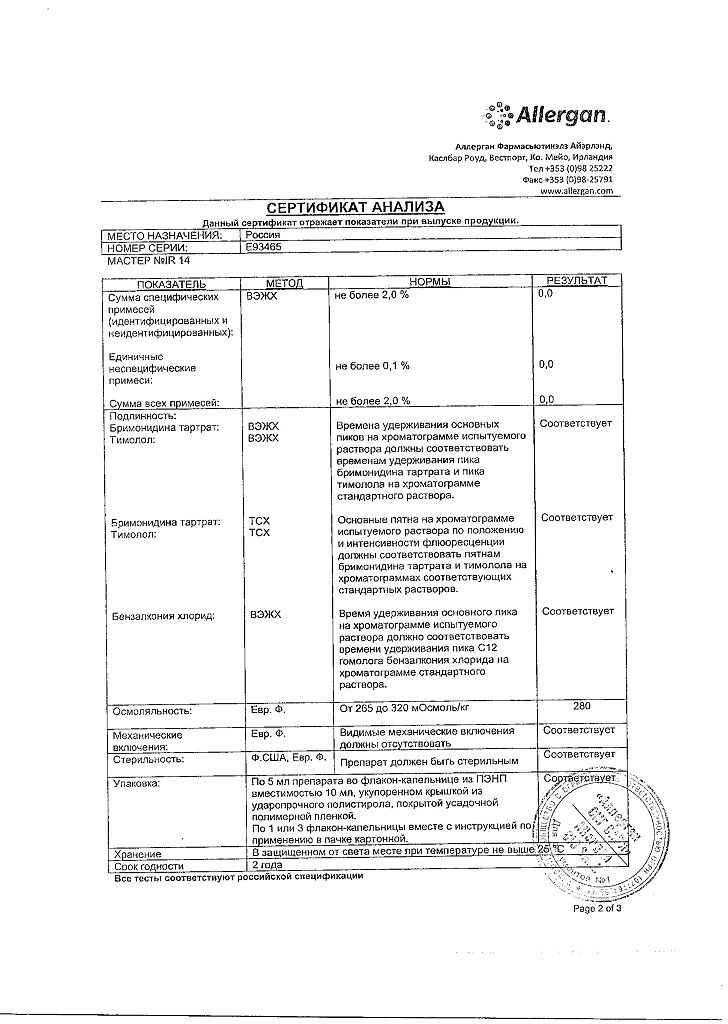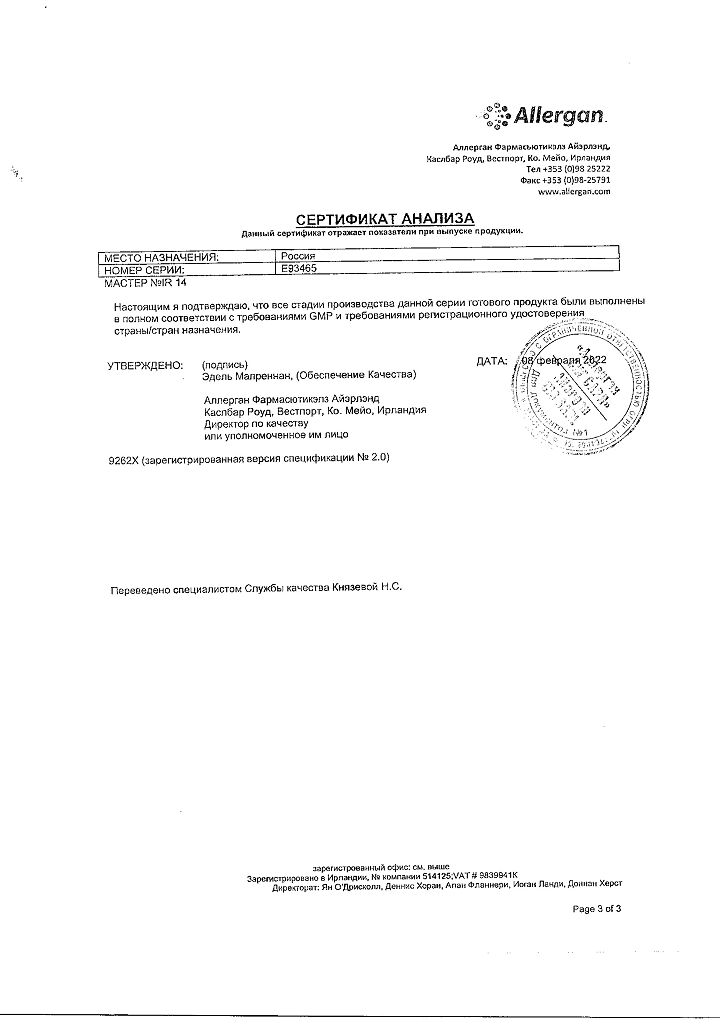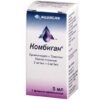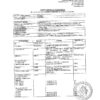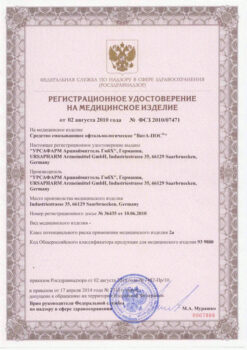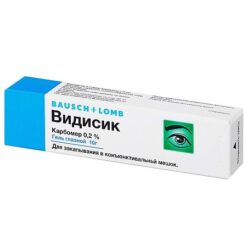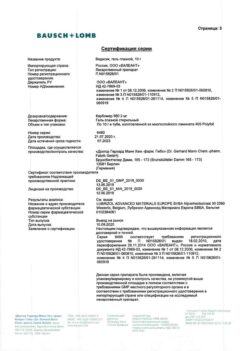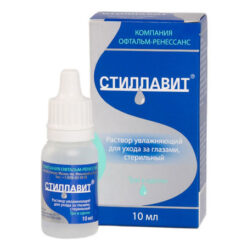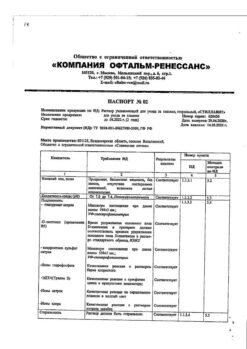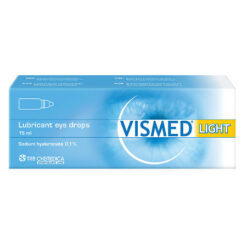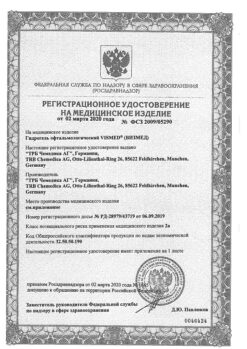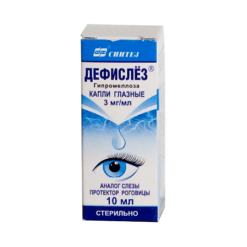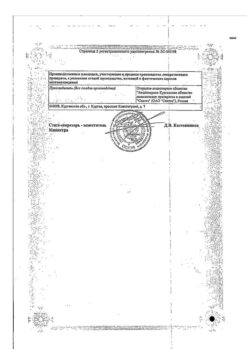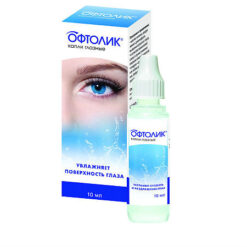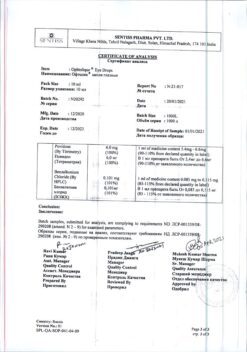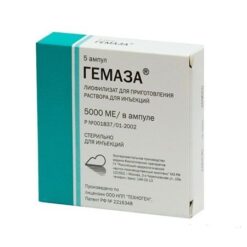No products in the cart.
Combigan, eye drops 5 ml
€30.97 €25.81
Description
Combigan is a combination drug that contains two active ingredients: the adrenomimetic brimonidine, which stimulates alpha2-adrenoreceptors, and the beta-adrenoreceptor blocker timolol. Both substances are able to reduce elevated intraocular pressure by mutual amplification of the effect, which makes the hypotensive effect more pronounced (compared to the effectiveness of each individual component).
The first component, brimonidine, being an alpha-adrenergic receptor antagonist, is thousands of times more selective for alpha2-adrenoreceptors compared to alpha1-adrenoreceptors. Its selectivity is expressed in the absence of vasoconstriction (vasoconstriction) and mydriasis (pupil dilation). Brimonidine provides a hypotensive effect by increasing the outflow of intraocular fluid through the uveoscleral pathway.
The second component, timolol, is a non-selective beta-adrenoreceptor blocker. It has no intrinsic membrane-stabilizing and sympathomimetic activity. The substance lowers intraocular pressure by reducing intraocular fluid formation. The mechanism of its action is not precisely defined; it may be related to inhibition of the synthesis of CAMP or caused by endogenous stimulation of beta-adrenergic receptors.
After instillation, the bulk of the drug is excreted by the kidneys as metabolites within 5 days.
Pharmacokinetics
Mean maximum plasma concentrations (Cmax) of brimonidine and timolol after administration of Combigan® prepatarator were 0.0327 and 0.406 ng/mL, respectively.
Brimonidine
Brimonidine plasma concentrations are very low when 0.2% solution is administered as eye drops. Brimonidine is slightly metabolized in the tissues of the eye, the binding to plasma proteins is about 29%. The half-life (T1/2) of the drug after topical application is on average about 3 hours.
Timolol
80% of timolol used in the form of eye drops enters the systemic bloodstream by absorption through the vessels of the conjunctiva, nasal mucosa and lacrimal tract. After instillation of the eye drops, the maximum concentration of timolol in the aqueous humor of the eye is reached after 1-2 hours. The half-life (T1/2) of timolol in blood plasma is about 7 hours. Timolol is insignificantly bound to plasma proteins. Timolol is partially metabolized in the liver; the active substance and its metabolites are excreted by the kidneys.
Indications
Indications
open-angle glaucoma;
intraocular hypertension.
The drug is recommended if the effectiveness of local beta-adrenergic receptor blockers is insufficient.
Pharmacological effect
Pharmacological effect
Combigan is a combination drug that contains two active substances: the adrenergic agonist brimonidine, which stimulates alpha2-adrenergic receptors, and the beta-adrenergic receptor blocker timolol. Both substances are capable of reducing elevated intraocular pressure due to mutual enhancement of the effect, which makes the hypotensive effect more pronounced (compared to the effectiveness of each individual component).
The first component, brimonidine, being an antagonist of alpha-adrenergic receptors, is characterized by thousands of times greater selectivity for alpha2-adrenergic receptors compared to alpha1-adrenergic receptors. Its selectivity is expressed in the absence of vasoconstriction (narrowing of blood vessels) and mydriasis (dilation of the pupil). Brimonidine provides a hypotensive effect by increasing the outflow of intraocular fluid along the uveoscleral pathway.
The second component, timolol, is a non-selective beta-adrenergic receptor blocker. It does not have internal membrane stabilizing and sympathomimetic activity. The substance lowers intraocular pressure by reducing the formation of intraocular fluid. The mechanism of its action has not been precisely established; it may be associated with the suppression of cAMP synthesis or caused by endogenous stimulation of beta-adrenergic receptors.
After instillation, the main volume of the drug is excreted by the kidneys in the form of metabolites within 5 days.
Pharmacokinetics
The average values of the maximum drug concentration in blood plasma (Cmax) of brimonidine and timolol after administration of Combigan® were 0.0327 and 0.406 ng/ml, respectively.
Brimonidine
When a 0.2% solution is administered in the form of eye drops, the concentration of brimonidine in the blood plasma is very low. Brimonidine is slightly metabolized in the tissues of the eye; its binding to plasma proteins is about 29%. The half-life (T1/2) of the drug after topical application is on average about 3 hours.
The main part of the drug (about 74% of the dose absorbed into the systemic circulation) is excreted by the kidneys in the form of metabolites within 5 days; unchanged drug is not found in the urine. In vitro studies on animal and human liver cells have shown that aldehyde oxidase and cytochrome P450 are largely involved in the metabolic process. Consequently, systemic elimination is determined primarily by the metabolism of the drug in the liver.
Timolol
80% of timolol, used in the form of eye drops, enters the systemic circulation through absorption through the vessels of the conjunctiva, nasal mucosa and lacrimal tract. After installation of eye drops, the maximum concentration of timolol in the aqueous humor of the eye is achieved after 1-2 hours. The half-life (T1/2) of timolol in blood plasma is about 7 hours. Timolol is slightly bound to plasma proteins. Timolol is partially metabolized in the liver; The active substance and its metabolites are excreted by the kidneys.
Special instructions
Special instructions
Like any ophthalmic agents for topical use, Combigan is capable of being absorbed systemically.
Before instillation of Combigan, contact lenses must be removed. They can be put on again no earlier than 15 minutes after the procedure.
It is unacceptable to touch the dispenser tip to any surfaces to avoid infection of the contents of the bottle and your eyes.
If allergic reactions occur, treatment with Combigan should be discontinued.
In patients with severely impaired renal function undergoing hemodialysis, treatment with timolol is accompanied by a pronounced decrease in blood pressure.
While taking a drug from the beta-blocker group in patients with agonic manifestations and severe anaphylactic reactions to various allergens in history, there may be a decrease or lack of effectiveness from the administration of epinephrine in usually used doses. Beta blockers may also mask symptoms of hyperthyroidism and worsen Prinzmetal’s angina, vascular disease, both peripheral and central, and hypotension.
Signs indicating acute hypoglycemia, in particular tachycardia, palpitations and sweating, may be masked during beta-blocker therapy.
If it is necessary to discontinue therapy with Combigan, as well as in the treatment of cardiovascular diseases with systemic beta-blockers, therapy is discontinued gradually to avoid the development of cardiac arrhythmias, myocardial infarction and/or sudden death, the risk of which increases with abrupt discontinuation of drugs in this group.
The excipient benzalkonium chloride contained in Combigan® may have an irritating effect on the mucous membrane of the eyes.
The shelf life of the drug after the first opening of the dropper bottle is 28 days. After the specified time has expired, it is recommended to throw away the dropper bottle, even if it still contains a residual amount of the drug. This is necessary in order to avoid the risk of infection. Patients are advised to write down the date the bottle was opened on the cardboard packaging.
Impact on the ability to drive vehicles and machinery
The drug can affect the ability to drive vehicles and machines, causing short-term blurred vision, sometimes weakness and drowsiness. If these symptoms occur, you should refrain from performing potentially hazardous activities.
Active ingredient
Active ingredient
Brimonidine, Timolol
Composition
Composition
1 ml of eye drop solution contains:
Active ingredients
Brimonidine tartrate – 2.0 mg/ml.
Timolol maleate – 6.8 mg/ml.
In terms of timolol – 5.0 mg/ml.
Excipients
Benzalkonium chloride,
sodium hydrogen phosphate heptahydrate,
sodium dihydrogen phosphate monohydrate,
hydrochloric acid,
sodium hydroxide,
water.
Pregnancy
Pregnancy
Contraindicated for children under 18 years of age.
There have been no controlled studies examining the use of Combigan in pregnant women.
Brimonidine
There are no data on the use of brimonidine in pregnant women. Animal studies have demonstrated reproductive toxicity at high doses with maternal toxicity. The degree of risk to humans has not been established.
Timolol
Animal studies have established reproductive toxicity when using doses of the drug that significantly exceed those recommended for use in clinical practice. Epidemiological studies have not revealed congenital malformations of the fetus, but there is a known risk of intrauterine growth retardation when taking beta-blockers orally. In addition, symptoms characteristic of the group of beta-blockers (bradycardia, decreased blood pressure, respiratory shortness of breath and hypoglycemia) were observed in newborns in cases where beta-blockers were used by the mother until delivery.
In this regard, if Combigan is prescribed during pregnancy until the moment of birth, medical monitoring of the newborn’s condition during the first days of life is necessary.
Combigan can be used during pregnancy only if absolutely necessary.
During lactation
Preclinical studies have shown that brimonidine and timolol are excreted in breast milk. Breastfeeding should be stopped during treatment.
Contraindications
Contraindications
Hypersensitivity to the components of the drug.
Increased airway reactivity, including:
Bronchial asthma.
Broncho-obstruction, incl. history of severe chronic obstructive pulmonary disease.
Sinus bradycardia.
Atrioventricular block II-III degree without an implanted artificial heart pacemaker.
Heart failure.
Cardiogenic shock.
Concomitant therapy with monoamine oxidase inhibitors (MAOIs), tricyclic and tetracyclic antidepressants (including mianserin).
Age up to 18 years.
Breastfeeding period.
With caution:
Renal/liver failure (the use of the drug has not been sufficiently studied in this group of patients).
Depression
Cerebral or coronary insufficiency.
Raynaud’s syndrome.
Orthostatic hypotension
Thromboangiitis obliterans.
Severe cardiovascular diseases of unstable course.
Diabetes mellitus.
Episodes of hypoglycemia (in the absence of therapy).
Pheochromocytoma (without previous treatment).
Metabolic acidosis.
Simultaneous use of radiocontrast agents.
Intravenous administration of lidocaine, blockers of “slow” calcium channels (verapamil, diltiazem) due to the risk of inhibition of atrioventricular conduction, development of bradycardia, heart failure and lowering blood pressure.
Simultaneous prescription or change in the dose of drugs taken from the groups of adrenomimetics (isoprenaline) and adrenoblockers (prazosin), as well as other drugs that affect adrenergic transmission – due to their possible interaction with the active components of the drug or changes in their therapeutic potential.
Side Effects
Side Effects
The most common side effects were hyperemia of the conjunctiva of the eye (about 15% of patients) and a burning sensation of the mucous membrane of the eye (about 11% of patients). In most cases, the severity of these symptoms was mild; discontinuation of therapy was required only in 3.4% and 0.5% of cases, respectively.
During clinical trials of the drug Combigan®, the following side effects were reported, taking into account the frequency of occurrence: very often (>1/10); often (>1/100.1/1000,
From the side of the organ of vision:
very often: hyperemia of the conjunctiva of the eye, burning sensation.
often: acute burning or stabbing pain, allergic conjunctivitis, corneal erosion, superficial keratitis, itching of the skin of the eyelids, conjunctival folliculosis, blurred vision, blepharitis, epiphora, dry mucous membrane of the eye, discharge from the eye, pain, irritation of the mucous membrane of the eye, foreign body sensation.
uncommon: decreased visual acuity, conjunctival edema, follicular conjunctivitis, allergic blepharitis, conjunctivitis, floating precipitates in the vitreous, asthenopia, photophobia, hypertrophy of the papillary muscles of the eye, eyelid pain, pallor of the conjunctiva, corneal edema, corneal infiltrates, vitreous rupture. Mental disorders: often – depression.
From the nervous system:
often – drowsiness, headache;
uncommon – dizziness, syncope.
From the cardiovascular system:
often – increased blood pressure;
uncommon: congestive heart failure, palpitations.
From the respiratory system:
uncommon: rhinitis, dry nasal mucosa.
From the digestive system:
often – dryness of the oral mucosa;
infrequently – a perversion of taste.
For the skin and subcutaneous fat:
often – swelling of the eyelids, itching of the skin of the eyelids, redness of the skin of the eyelids;
infrequently – allergic contact dermatitis.
Other violations:
often – asthenic conditions.
Laboratory indicators: often – increased activity of liver enzymes.
The following side effects have been additionally reported since Combigan was introduced to the market:
From the cardiovascular system:
Frequency unknown – arrhythmia, bradycardia, tachycardia, decreased blood pressure.
Side effects that were observed when using one of the active ingredients, the possibility of which cannot be excluded when using the drug Combigan:
Brimonidine
From the organ of vision: iridocyclitis, miosis.
Mental disorders: insomnia.
From the respiratory system: inflammatory diseases of the upper respiratory tract, shortness of breath.
From the digestive system: taste perversion, dyspepsia. Other: systemic allergic reactions.
Timolol
From the organ of vision: decreased sensitivity of the cornea, diplopia, ptosis, rupture of the choroid (after filtration surgical treatment), changes in refraction (due to withdrawal of miotic therapy in some cases).
Mental disorders: insomnia, nightmares, decreased libido.
From the nervous system: memory loss, worsening symptoms of myasthenia gravis, paresthesia, cerebral ischemia. On the part of the hearing organ: tinnitus.
From the cardiovascular system: complete transverse heart block, cardiac arrest.
Vascular disorders: cerebrovascular accident, intermittent claudication, Raynaud’s syndrome, cold extremities. From the respiratory system: bronchospasm (mainly in patients with a history of broncho-obstructive diseases), shortness of breath, cough, respiratory failure.
From the digestive system: nausea, diarrhea, dyspepsia.
From the skin and subcutaneous fat: alopecia, psoriasis-like rash or exacerbation of psoriasis.
From the musculoskeletal system, connective and bone tissue: systemic lupus erythematosus
Other: peripheral edema, Peyronie’s disease, chest pain.
Interaction
Interaction
No special studies have been conducted to study drug interactions with Combigan®. However, the possibility of enhancing the effect of drugs that depress the central nervous system (alcohol, barbiturates, opium derivatives, sedatives, general anesthetics) when used simultaneously with Combigan should be taken into account.
Timolol may exacerbate compensatory tachycardia and increase the risk of a pronounced decrease in blood pressure when used with general anesthetics. It is necessary to warn the anesthesiologist about the use of the drug Combigan before the upcoming operation.
With the simultaneous use of timolol and epinephrine, mydriasis may develop.
Beta-blockers may enhance the hypoglycemic effect of hypoglycemic drugs. They may also mask hypoglycemia.
The hypertensive reaction to abrupt discontinuation of clonidine may be exacerbated by the use of a beta blocker.
An increase in the hypotensive effect (for example, a decrease in heart rate) when timolol is used together with quinidine is possible due to the fact that quinidine slows down the metabolism of timolol through the cytochrome P450 isoenzyme, CYP2D6.
The combined use of beta-blockers with drugs for general anesthesia may hide compensatory tachycardia and increase the risk of a pronounced decrease in blood pressure, therefore the anesthesiologist must be warned about the patient’s use of the drug Combigan.
Cimetidine, hydralazine, ethanol can increase the concentration of timolol in the blood plasma.
It is necessary to use with caution drugs that affect the metabolism and absorption of circulating catecholamines, for example, chlopromazine, methylphenidate, reserpine. Concomitant use of MAO inhibitors is contraindicated. For patients receiving MAO inhibitors, treatment with Combigan can be prescribed 14 days after discontinuation of the MAO inhibitor.
Potentiation of the effects of combined use of eye drops containing timolol and ingested calcium channel blockers, guanethidine or beta-blockers, antiarrhythmic drugs, cardiac glycosides or parasympathomimetics has been reported, which was manifested by a pronounced decrease in blood pressure and/or severe bradycardia. After using brimonidine in very rare cases (
Overdose
Overdose
Brimonidine.
When applied topically: loss of consciousness, significant decrease in blood pressure, bradycardia, increased body temperature, cyanosis and apnea.
When taken orally: short-term confusion, central nervous system depression, loss of consciousness or coma, marked decrease in blood pressure, bradycardia, increased body temperature, cyanosis and apnea.
Treatment: Urgent hospitalization.
Timolol.
General overdose: bradycardia, marked decrease in blood pressure, bronchospasm, dizziness, headache, cardiac arrest.
Treatment: symptomatic therapy, hemodialysis is ineffective.
Storage conditions
Storage conditions
In a place protected from light, at a temperature not exceeding 25 °C
Shelf life
Shelf life
1 year 9 months
Manufacturer
Manufacturer
Allergan Pharmaceuticals Ireland, Ireland
Additional information
| Shelf life | 1 year 9 months |
|---|---|
| Conditions of storage | In a light-protected place, at a temperature not exceeding 25 °C |
| Manufacturer | Allergan Pharmaceuticals Ireland |
| Medication form | eye drops |
| Brand | #Н/Д |
Related products
Buy Combigan, eye drops 5 ml with delivery to USA, UK, Europe and over 120 other countries.



